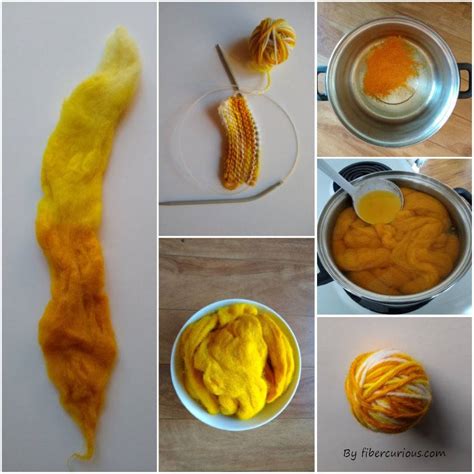How To Dye With Turmeric
Ronan Farrow
Mar 24, 2025 · 4 min read

Table of Contents
How to Dye With Turmeric: A Beginner's Guide to Natural Dyeing
Turmeric, the vibrant golden spice that flavors curries and adds a pop of color to many dishes, also makes a fantastic natural dye! Its earthy yellow hue can create beautiful shades on various fabrics, offering a sustainable and eco-friendly alternative to synthetic dyes. This comprehensive guide will walk you through the process of dyeing with turmeric, from preparation to achieving the perfect shade.
Getting Started: Materials You'll Need
Before you begin your turmeric dyeing adventure, gather these essential materials:
- Turmeric Powder: The higher the quality, the richer the color. Look for organic, unadulterated turmeric powder.
- Fabric: Natural fibers like cotton, linen, silk, and wool work best. Pre-wash your fabric to remove any sizing or finishes that might hinder dye absorption.
- Water: Plenty of clean water is crucial for effective dyeing.
- Pot: A stainless steel or enamel-coated pot is recommended to avoid any reaction with the dye. Avoid using aluminum.
- Gloves: Protect your hands from staining.
- Heat Source: A stovetop is ideal.
- Mordant (Optional but Recommended): A mordant is a substance that helps the dye bind to the fibers, resulting in more vibrant, colorfast results. Common mordants include alum, tannic acid (from tea), or iron. More on mordants below.
- Measuring tools: Accurate measurements ensure consistent dye baths.
- Spatula or spoon: To stir the dye bath gently.
- Clean container: To hold the fabric during the dying process.
Preparing Your Fabric: The Importance of Pre-Treatment
Pre-treating your fabric is vital for achieving the best possible results. This involves washing the fabric thoroughly to remove any finishes that may prevent proper dye absorption. Here's a simple pre-treatment process:
- Wash: Wash your fabric in hot water with a mild detergent.
- Rinse: Rinse thoroughly until all soap residue is gone.
- Dry: Allow the fabric to dry completely before mordanting (if using).
Mordanting: The Secret to Vibrant Color
Mordanting is a crucial step that enhances the colorfastness and vibrancy of your turmeric dye. It helps the dye molecules bind to the fabric fibers, preventing fading and making the color last longer.
How to Mordant:
The method of mordanting depends on the mordant used. Generally, you’ll need to soak your fabric in a solution of the mordant and water, following the instructions specific to the mordant you've chosen. This usually involves simmering the fabric in the mordant solution for an extended period. Always refer to the mordant packaging for specific instructions on ratios and simmering times.
The Dyeing Process: Step-by-Step Instructions
- Prepare the dye bath: Add a generous amount of turmeric powder to a pot filled with water. The ratio typically is around 1-2 cups of turmeric per gallon of water, but feel free to experiment. The more turmeric, the richer and deeper the yellow.
- Simmer: Bring the mixture to a simmer, stirring occasionally, to ensure the turmeric is completely dissolved and the dye is fully extracted.
- Add fabric: Once simmering, gently add the pre-treated and (if used) mordanted fabric to the dye bath. Make sure the fabric is completely submerged.
- Simmer and stir: Simmer the fabric in the dye bath for at least 30 minutes to an hour, stirring gently every 15 minutes to ensure even dyeing. The longer you simmer, the deeper the color.
- Remove and rinse: Carefully remove the fabric from the dye bath using tongs or gloves. Rinse the fabric under cold running water until the water runs clear.
- Dry: Hang your dyed fabric to air dry. Avoid direct sunlight, which may cause fading.
Achieving Different Shades
Experimentation is key to achieving different shades with turmeric. Consider these factors:
- Quantity of Turmeric: More turmeric equals a deeper, richer yellow.
- Dyeing Time: Longer dyeing times result in more intense colors.
- Mordant: Different mordants can influence the final shade.
Aftercare and Maintenance
To maintain the vibrancy of your turmeric-dyed fabric, follow these care instructions:
- Wash separately: Wash your turmeric-dyed items separately from other clothing, especially the first few times, as some bleeding might occur.
- Cold water wash: Use cold or lukewarm water and a gentle detergent.
- Air dry: Air drying is always preferable to machine drying, which can damage the dye.
Dyeing with turmeric is a rewarding experience that connects you to a rich tradition of natural dyeing. By following these steps and experimenting with different techniques, you can create beautiful and unique pieces. Remember, patience and practice are key to mastering this art form!
Featured Posts
Also read the following articles
| Article Title | Date |
|---|---|
| How To Dispose Of Sharps Containers In Georgia | Mar 24, 2025 |
| How To Cut A Keyway In A Shaft | Mar 24, 2025 |
| How To Fight Cell Phone Ticket California | Mar 24, 2025 |
| How To Get Rid Of Yellow Teeth With Braces | Mar 24, 2025 |
| How To Cut Fibreglass Rods | Mar 24, 2025 |
Latest Posts
-
How Far Is Cuba From Key West By Boat
Apr 04, 2025
-
How Far Is Cinnamon Beach From St Augustine
Apr 04, 2025
-
How Far Is Carriacou From Grenada
Apr 04, 2025
-
How Far Is Beach From Me
Apr 04, 2025
-
How Far Is A Light Year Painting
Apr 04, 2025
Thank you for visiting our website which covers about How To Dye With Turmeric . We hope the information provided has been useful to you. Feel free to contact us if you have any questions or need further assistance. See you next time and don't miss to bookmark.
